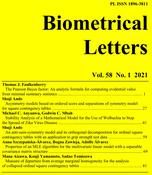
Biometrical Letters Vol. 58(1), 2021, pp. 81-94


In clinical research, collected data are often classified into ordered categories using a set threshold to evaluate efficacy and safety of treatment. Data can be summarized as a shift table, which displays the change in the frequency of subjects across specified categories from the baseline to post-baseline. Although ordered categories are sometimes recombined into three categories, the combined patterns vary. To consider various collapsed patterns comprehensively, this paper proposes a new measure that represents the degree of departure from average marginal homogeneity, and can distinguish between two kinds of marginal inhomogeneity. Additionally, applications of the proposed measure to clinical data are discussed.

Collapsed table, marginal homogeneity, measure

